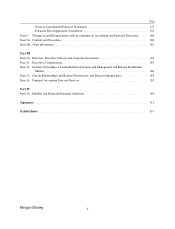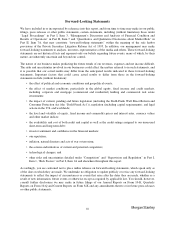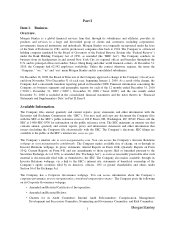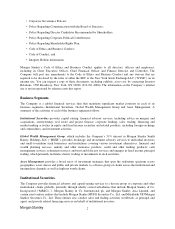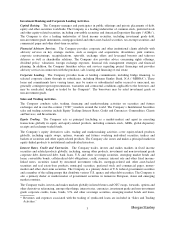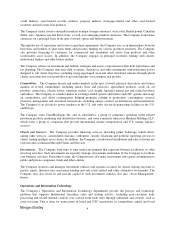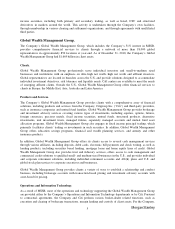Morgan Stanley 2010 Annual Report Download - page 14
Download and view the complete annual report
Please find page 14 of the 2010 Morgan Stanley annual report below. You can navigate through the pages in the report by either clicking on the pages listed below, or by using the keyword search tool below to find specific information within the annual report.
The Company has experienced intense price competition in some of its businesses in recent years. In particular,
the ability to execute securities trades electronically on exchanges and through other automated trading markets
has increased the pressure on trading commissions. The trend toward direct access to automated, electronic
markets will likely continue. It is possible that the Company will experience competitive pressures in these and
other areas in the future as some of its competitors may seek to obtain market share by reducing prices.
Asset Management.
Competition in the asset management industry is affected by several factors, including the Company’s reputation,
investment objectives, quality of investment professionals, performance of investment strategies or product
offerings relative to peers and an appropriate benchmark index, advertising and sales promotion efforts, fee
levels, the effectiveness of and access to distribution channels and investment pipelines, and the types and quality
of products offered. The Company’s alternative investment products, such as private equity funds, real estate and
hedge funds, compete with similar products offered by both alternative and traditional asset managers.
Supervision and Regulation.
As a major financial services firm, the Company is subject to extensive regulation by U.S. federal and state
regulatory agencies and securities exchanges and by regulators and exchanges in each of the major markets
where it operates. Moreover, in response to the financial crisis, legislators and regulators, both in the U.S. and
around the world, are in the process of adopting and implementing a wide range of reforms that will result in
major changes to the way the Company is regulated and conducts its business. It will take some time for the
comprehensive effects of these reforms to emerge and be understood.
Regulatory Outlook.
On July 21, 2010, President Obama signed the Dodd-Frank Act into law. While certain portions of the Dodd-
Frank Act were effective immediately, other portions will be effective only following extended transition
periods. At this time, it is difficult to assess fully the impact that the Dodd-Frank Act will have on the Company
and on the financial services industry generally. Implementation of the Dodd-Frank Act will be accomplished
through numerous rulemakings by multiple governmental agencies. The Dodd-Frank Act also mandates the
preparation of studies on a wide range of issues, which could lead to additional legislation or regulatory changes.
In addition, legislative and regulatory initiatives continue outside the U.S. which may also affect the Company’s
business and operations. For example, the Basel Committee on Banking Supervision (the “Basel Committee”)
has issued new capital, leverage and liquidity standards, known as “Basel III,” which U.S. banking regulators are
expected to introduce in the U.S. The Financial Stability Board and the Basel Committee are also developing
standards designed to apply to systemically important financial institutions, such as the Company. In addition,
initiatives are under way in the European Union and Japan, among other jurisdictions, that would require
centralized clearing, reporting and recordkeeping with respect to various kinds of financial transactions and other
regulatory requirements that are in some cases similar to those required under the Dodd-Frank Act.
It is likely that the year 2011 and subsequent years will see further material changes in the way major financial
institutions are regulated in both the U.S. and other markets in which the Company operates, though it is difficult
to predict which further reform initiatives will become law, how such reforms will be implemented or the exact
impact they will have on the Company’s business, financial condition, results of operations and cash flows for a
particular future period.
Financial Holding Company.
The Company has operated as a bank holding company and financial holding company under the BHC Act since
September 2008. Effective July 22, 2010, as a bank holding company with $50 billion or more in consolidated
assets, the Company became subject to the new systemic risk regime established by the Dodd-Frank Act. It is not
yet clear how the regulators will apply the heightened prudential standards on systemically important firms such
as the Company.
8


